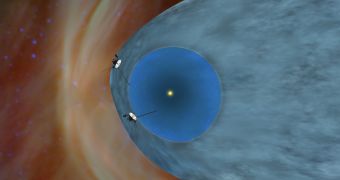The Voyager 1 probe has been providing interesting and unexpected data about the edge of the solar system for years. For the past couple of years, scientists have been expecting the probe to leave the sun's influence behind and become the first manmade object to reach interstellar space.
But it hasn't happened yet. Instead, scientists are observing strange behavior and regions they didn't expect to find.
In several papers just published, astronomers are trying to make sense of the strange region Voyager 1 entered last August and is still inside of.
At first, scientists believed Voyager 1 actually left the solar system. The solar wind slowed down considerably over just a few days to the point where it became undetectable.
Scientists also detected an increase in high energy particles that come from outside of the solar system and are normally pushed away by the solar wind.
"We saw a dramatic and rapid disappearance of the solar-originating particles. They decreased in intensity by more than 1,000 times, as if there was a huge vacuum pump at the entrance ramp onto the magnetic highway," Stamatios Krimigis, who is in charge of data from the low-energy particle detector on Voyager 1, said.
"We have never witnessed such a decrease before, except when Voyager 1 exited the giant magnetosphere of Jupiter, some 34 years ago," he added.
Those are two big signs that Voyager left the solar system where low-energy particles from the sun dominate and entered interstellar space where high-energy particles from supernovas and other massive cosmic events are believed to much more common.
But a third sign that would tell astronomers that Voyager has really left the solar system was not detected, as there hasn't been any change in the angle of the magnetic field around the probe. Voyager 1 is still under the influence the sun's magnetic field, so it's technically not in interstellar space.
At the current time, there's no model that really explains what Voyager is seeing. There's no way to know how much more Voyager 1 has to travel to leave the sun's influence behind either, and estimates range from months to years.
That's unless the probe finds something else that scientists weren't expecting, but they aren't making any more predictions at this point.

 14 DAY TRIAL //
14 DAY TRIAL //